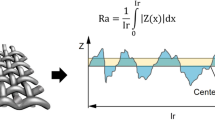Abstract
THE well-known and characteristic tints that appear on the surface of a tarnishable metal when it is heated in contact with air have been usually regarded as interference colours due to the formation of a thin film of oxide on the surface of the metal. The correctness of this explanation has, however, recently been questioned (A. Mallock, Proc. Roy. Soc., 1918), and rightly so, as a continuous film on a strongly reflected surface cannot on optical principles be expected to exhibit such vivid colours as those observed.
This is a preview of subscription content, access via your institution
Access options
Subscribe to this journal
Receive 51 print issues and online access
$199.00 per year
only $3.90 per issue
Buy this article
- Purchase on Springer Link
- Instant access to full article PDF
Prices may be subject to local taxes which are calculated during checkout
Similar content being viewed by others
Author information
Authors and Affiliations
Rights and permissions
About this article
Cite this article
RAMAN, C. The Colours of Tempered Steel. Nature 109, 105–106 (1922). https://doi.org/10.1038/109105b0
Issue Date:
DOI: https://doi.org/10.1038/109105b0
Comments
By submitting a comment you agree to abide by our Terms and Community Guidelines. If you find something abusive or that does not comply with our terms or guidelines please flag it as inappropriate.



